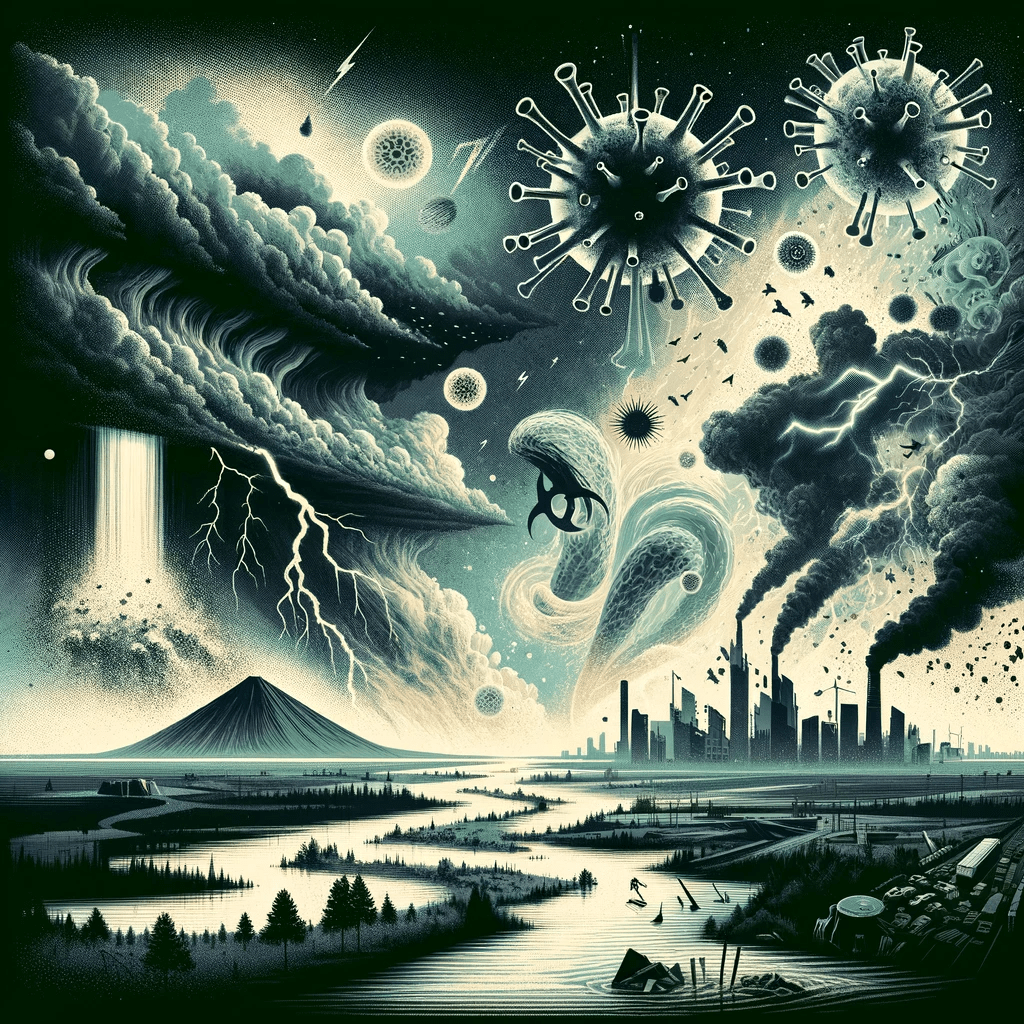Catastrophic Events

Historical catastrophic events have shaped the course of human history and left lasting impacts on societies and the environment. These events, which include natural disasters, pandemics, and human-induced catastrophes, have been both devastating and transformative. While each event is unique, they all share common elements such as immense destruction, significant loss of life, and long-term consequences for affected populations.
Historical Catastrophic Events
One example of a catastrophic event is the eruption of Mount Vesuvius in 79 AD. This volcanic eruption destroyed the Roman cities of Pompeii and Herculaneum, burying them under a thick layer of ash and pumice. The eruption killed an estimated 16,000 people and left a lasting impression on the cultural memory of the Roman Empire. The event has been well-documented by historians and archeologists, who have used the preserved ruins of Pompeii to gain insights into daily life in ancient Rome.
Another major historical catastrophe is the Black Death, a deadly pandemic that swept through Eurasia in the mid-14th century, claiming the lives of an estimated 75-200 million people. The pandemic was caused by the bacterium Yersinia pestis, which was transmitted through fleas carried by rodents. The Black Death radically altered European society, leading to social and economic upheaval, as well as a decline in the population that took centuries to recover.
In more recent history, the 1931 China floods rank among the deadliest natural disasters ever recorded. A combination of melting snow and heavy rainfall caused the Yangtze, Yellow, and Huai rivers to overflow, resulting in catastrophic flooding that affected millions of people. Estimates of the death toll range from 1-4 million, with millions more left homeless and facing food shortages. The floods led to significant political and social change, contributing to the eventual fall of the Nationalist government in China.
The science behind these catastrophic events varies depending on the type of event. For example, volcanic eruptions like that of Mount Vesuvius are caused by the movement of tectonic plates and the release of magma from the Earth’s mantle. The Black Death, on the other hand, was a biological catastrophe, resulting from the spread of a highly contagious and deadly bacterium. Floods, like those in China in 1931, are typically caused by excessive precipitation and the inability of rivers and drainage systems to cope with the volume of water.
The volcanic ash from the eruption of Mount Vesuvius in 79 AD was so thick that it blocked out the sun, causing total darkness for days (Source: Sigurdsson, H., et al. (2002). “The Eruption of Vesuvius in A.D. 79: Reconstruction from Historical and Volcanological Evidence.” American Journal of Archaeology, 106(1), 93-100).
The Black Death is believed to have killed between 30-60% of Europe’s population during the 14th century (Source: Benedictow, O.J. (2004). The Black Death, 1346-1353: The Complete History. Woodbridge: Boydell Press).
The 1931 China floods caused the destruction of an estimated 25 million acres of farmland (Source: Edmonds, R. L. (1994). Patterns of China’s Lost Harmony: A Survey of the Country’s Environmental Degradation and Protection. London: Routledge).
Future Catastrophic Events
The risk of future historical catastrophic events is an important issue that concerns scientists, governments, and citizens around the world. As our planet’s climate changes, urbanization increases, and global interconnectivity expands, the potential for disasters that can have significant impacts on human societies and the environment becomes even more relevant. Whether it is natural disasters, pandemics, or human-induced catastrophes, understanding the risks associated with these events is crucial for ensuring preparedness and resilience in the face of adversity.
Climate change is one of the most pressing concerns for the future of our planet. As global temperatures continue to rise, the frequency and intensity of extreme weather events, such as hurricanes, floods, and droughts, are expected to increase. This can lead to widespread destruction, loss of life, and economic hardship for affected communities. Additionally, climate change can exacerbate existing environmental issues, such as the loss of biodiversity and the degradation of ecosystems.
Climate change has occurred naturally throughout Earth’s history. Factors such as variations in Earth’s orbit, changes in solar radiation, and volcanic activity can contribute to climate fluctuations. Human activities may also be contributing.
Some key examples of climate change evidence include:
- Rising global temperatures: According to the Intergovernmental Panel on Climate Change (IPCC), the average global temperature has increased by approximately 1.2°C (2.16°F) since the late 19th century. This increase is primarily attributed to the release of greenhouse gases, such as carbon dioxide and methane, through human activities like burning fossil fuels and deforestation.
- Shrinking ice sheets and glaciers: The Greenland and Antarctic ice sheets have been losing mass at an accelerating rate, contributing to rising sea levels. Additionally, glaciers worldwide, from the Andes to the Himalayas, have been retreating due to increasing temperatures.
- Rising sea levels: Global sea levels have risen by about 20 centimeters (8 inches) since 1900, with the rate of rise increasing in recent decades. This is primarily due to the melting of ice sheets and glaciers, as well as the thermal expansion of seawater as it warms.
- Ocean acidification: As the oceans absorb more carbon dioxide from the atmosphere, their pH levels decrease, leading to increased acidity. Ocean acidification has negative impacts on marine ecosystems, particularly organisms that rely on calcium carbonate for their shells or skeletons, such as coral reefs and shellfish.
- Changes in precipitation patterns: Climate change has led to alterations in precipitation patterns, with some regions experiencing more intense and frequent rainfall, while others face prolonged droughts. These changes can have significant consequences for agriculture, water resources, and flood management.
- More frequent and intense extreme weather events: Climate change has been linked to an increase in the frequency and severity of extreme weather events, such as heatwaves, hurricanes, and wildfires. These events can cause widespread destruction, loss of life, and economic hardship for affected communities.
- Changes in the distribution of plants and animals: As temperatures rise and ecosystems are altered, the distribution of plant and animal species is shifting. Many species are moving towards higher elevations or closer to the poles in search of cooler habitats. These shifts can lead to local extinctions and the disruption of ecosystems.
- Loss of Arctic sea ice: The extent of Arctic sea ice has been declining rapidly, with the ice-free season becoming longer. This loss of sea ice has significant implications for global climate patterns, as well as the Arctic ecosystem and the communities that depend on it.
Another significant concern is the risk of future pandemics. As human populations grow and encroach upon natural habitats, the potential for novel diseases to emerge and spread increases. Furthermore, global travel and trade networks can enable the rapid transmission of infectious diseases, posing a serious threat to global health and security.
Human-induced catastrophes, such as nuclear accidents or acts of terrorism, also represent potential future historical catastrophic events. These incidents can have far-reaching consequences, both in terms of the immediate impacts on affected populations and the long-term geopolitical repercussions.
A 2018 report by the Intergovernmental Panel on Climate Change (IPCC) warns that the world has only 12 years to limit global warming to a maximum of 1.5°C to avoid the worst effects of climate change, such as increased extreme weather events and the loss of coral reefs (Source: IPCC, 2018. Global Warming of 1.5°C.).
The World Health Organization (WHO) estimates that, between 2011 and 2018, there were over 1,100 epidemic events reported, with infectious diseases accounting for nearly 70% of these events (Source: World Health Organization, 2021. Annual Review of Diseases Prioritized under the Research and Development Blueprint.
In 2017, the United Nations Office for Disarmament Affairs reported that there were approximately 14,000 nuclear warheads in the world, with many of these weapons on high alert status, increasing the risk of accidental or intentional use (Source: United Nations Office for Disarmament Affairs, 2017).
Books on the subject, such as “The Uninhabitable Earth: Life After Warming” by David Wallace-Wells, explore the potential consequences of climate change and other future catastrophic events. Wallace-Wells’ book claims that, without significant action to reduce greenhouse gas emissions and adapt to the changing climate, we may face a future marked by widespread suffering and societal upheaval.
By studying these events, we can learn valuable lessons about the causes and impacts of disasters, as well as the importance of preparation and resilience. As we continue to face new challenges in the future, it is crucial that we rely on accurate and credible information to guide our understanding and decision-making.



